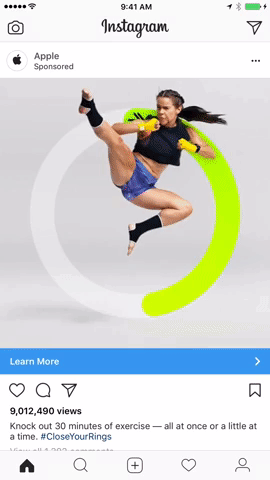
There is no shortage of possibilities when it comes to advertising your app. And if you’re like most marketers, you’re going to be directing a significant portion of your efforts to video this year. According to eMarketer, video made up 61% of app install budget allocation in fall 2017, and is only expected to increase.
But even within the realm of video, there are endless possibilities. In this post we’ll break down how app marketers are using video to drive app installs: how much of your budget it often requires, the best (and worst) platforms to choose from, and ways that marketers are using it effectively (and not).
Top Platforms: The Best Bang for Your Buck
According to eMarketer, brands have spent more than half of their digital budgets on video over the past two years. Of app install video budgets, 30% was directed toward full-screen video, 24% to social video, and 7% for in-feed video.
Unfortunately, there is no cut-and-dried way to estimate cost per impression or click. It depends on a lot of factors — your audience, budget, length of ad, duration, and so on. What we do know is that certain publishers offer more for your money, depending on your niche and business. Let’s take a look at a few.
Last year, Twitter announced several video-friendly feature updates, including video website cards to surface highly engaging video content that drives users to a site or action. According to several publishers, Twitter has delivered more video views than usual over the past few months — perhaps vying for marketer attention after Facebook announced it would be limiting branded content in news feeds.
Snapchat
If you’re a larger company, Snapchat may be a viable avenue. Snapchat works with more than 397 major brands such as Lyft, Pepsi, and Olay, who pay for video ads on Snapchat’s Discover channels. While Facebook, in contrast, has more than 5 million advertisers of all sizes, Snapchat focuses on big brands vying for limited inventory. Snap, the company that publishes the Snapchat app, is forecast to book $1.7 billion in advertising in 2018 alone.
Instagram is a noteworthy video advertising option for a few reasons. One, Instagram has always been a mobile-first platform, which makes it perfect for mobile app install ads. Secondly, Instagram Stories (the Instagram equivalent to Snapchat) has surpassed Snapchat in daily user count, with 200 million users. In fact, Instagram has more than 600 million monthly active users, which have attracted more than 1 million advertisers.
With Instagram, marketers can choose between Instagram carousel ads, which allow users to swipe through several photos or videos in one ad:

Or story ads, which are vertical video ads inserted into the Instagram Stories that play automatically as users swipe through:

Lastly, LinkedIn rolled out native videos last August, which publishers like the Financial Times, The Economist, and CNBC are testing.
Business Development Manager Jessica Chan at LinkedIn said that LinkedIn is partnering with a limited number of publishers on early access to new tools and products. “We’ve heard from some publishers that they are seeing impressive views and distribution of their videos and promising growth in follower counts since joining the pilot,” she said.
TikTok
While the viral app company is still working on and rolling out its official business marketing tools, TikTok offers video marketing through its main source of content: the creators. If you’re interested in trying this emerging platform, check out our article to learn how to find TikTok influencers and content creators to work with.
How to Add Video to Your App Marketing Strategy
If you’re planning to refresh your video app advertising strategy this year, here are a few things to consider.
1. Reallocate the resources to do it right.
You can either outsource videos to a third-party vendor or consider an in-house team. Glamour UK, for example, recently downsized their staff, but created a 5-person video team in order to increase user engagement through more compelling video marketing and long-form content.
2. Reward users for watching.
Many publishers struggle with users skipping through video ads or clicking out before watching a full video. But 40% of consumers say they would watch watch a video ad if they got something in return, like a coupon — and a full 87% of consumers rated rewarded video ads as a positive user experience. So if you struggle with getting users to watch your full videos, you could either rework the creative, or include a little more incentive.
3. Play around with interactive videos.
The beauty of mobile is that it can engage customers far more than watching a static TV commercial. In fact, interactive ads achieve 3X the conversion rate of normal video ads. With interactive videos, you can gamify your advertisements to make users play along or let them choose their own adventure in an advertisement. For example, in this example by Candy Crush, viewers get a 15-second preview of what it’s like to play the game, enticing them to download the app for more.
The ultimate goal of video, like other formats, is acquiring and retaining customers. You can either choose to start on one platform where your users spend most of their time, or choose a few different platforms and compare effectiveness. Your videos should be an extension of your brand, bringing to life your colors, ethos, and personality — in motion.
Tell us in the comments below: Are you already using video, or planning to in 2018? What’s working, what’s not, and why? We’d like to hear from you!
Author
Becky is the Senior Content Marketing Manager at TUNE. Before TUNE, she handled content strategy and marketing communications at several tech startups in the Bay Area. Becky received her bachelor's degree in English from Wake Forest University. After a decade in San Francisco and Seattle, she has returned home to Charleston, SC, where you can find her strolling through Hampton Park with her pup and enjoying the simple things in life.




Leave a Reply
You must be logged in to post a comment.